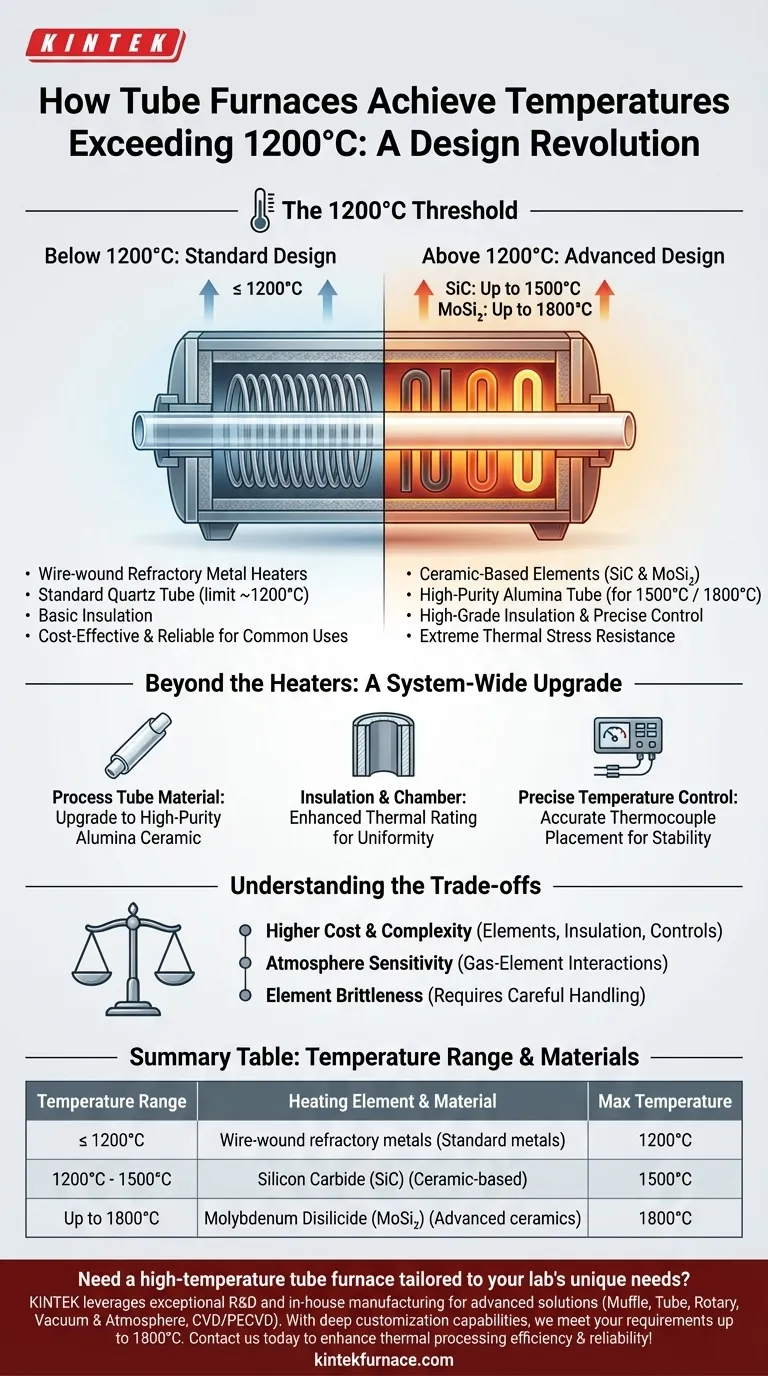The key design change for tube furnaces operating above 1200°C lies in the material of the heating elements themselves. While standard furnaces rely on wire-wound metal heaters, high-temperature models transition to specialized ceramic-based elements capable of withstanding extreme thermal stress without degrading. This fundamental shift in material science is what unlocks higher processing temperatures.
To exceed 1200°C, a tube furnace's design moves away from traditional wire-wound heaters. Instead, it must utilize advanced heating elements made from materials like Silicon Carbide (SiC) or Molybdenum Disilicide (MoSi₂) to achieve temperatures up to 1800°C.
The 1200°C Threshold: A Tale of Two Designs
The 1200°C mark is a critical dividing line in furnace engineering. The choice of heating element technology dictates the furnace's maximum operating temperature, cost, and overall capabilities.
Below 1200°C: The Realm of Wire-Wound Heaters
Most standard tube furnaces are designed for continuous use at or below 1200°C.
These models feature heating elements made from wire-wound refractory metals. These wires are typically coiled and embedded directly into the walls of the thermally insulated chamber surrounding the process tube.
This design is reliable and cost-effective for a vast range of common applications like basic annealing and thermal decomposition.
Above 1200°C: The Shift to Advanced Ceramic Elements
To safely and reliably generate higher temperatures, the design must incorporate different materials.
The first step up involves using Silicon Carbide (SiC) heating elements. These are often supplied as solid rods or U-shaped bars and can achieve sustained working temperatures of up to 1500°C.
For the most demanding applications, furnaces are equipped with Molybdenum Disilicide (MoSi₂) heating elements. These advanced components can reach extreme temperatures, enabling processes at up to 1800°C.
Beyond the Heaters: A System-Wide Upgrade
Achieving high temperatures is not just about the heating elements. The entire system must be engineered to withstand the intense environment.
The Process Tube Material
The tube that holds the sample is just as critical as the heaters. A standard quartz tube is excellent for its thermal shock resistance but typically reaches its limit around 1200°C.
For processes running at 1500°C or 1800°C, the process tube must also be upgraded to a higher-grade material, such as a high-purity alumina ceramic, which can maintain its structural integrity at those temperatures.
Insulation and Chamber Integrity
The thermal insulation packed around the heating elements must also be rated for higher temperatures. Inadequate insulation leads to poor temperature uniformity, excessive energy consumption, and potential damage to the furnace casing and electronics.
Precise Temperature Control
All tube furnaces, regardless of temperature range, rely on a thermocouple to provide real-time temperature feedback to the controller. In high-temperature systems, the accuracy and placement of this sensor are paramount for maintaining stability and preventing thermal runaway.
Understanding the Trade-offs
Selecting a high-temperature furnace involves clear performance and cost considerations.
Cost and Complexity
Furnaces equipped with SiC or MoSi₂ elements are significantly more expensive than their wire-wound counterparts. The cost of the elements themselves, along with the required high-grade insulation and more sophisticated power controllers, drives up the price.
Atmosphere Control
While all tube furnaces offer superior atmosphere control by allowing direct gas flow, the choice of process gas can impact the lifespan of the heating elements. Certain atmospheres can react with SiC or MoSi₂ at very high temperatures, a factor that must be considered during process design.
Element Brittleness
Ceramic heating elements like SiC and MoSi₂ are more brittle than metal wires. They require careful handling during installation and can be more susceptible to mechanical shock.
Making the Right Choice for Your Application
Your required process temperature is the single most important factor in selecting a furnace design.
- If your primary focus is processing at or below 1200°C: A standard furnace with wire-wound elements is the most practical and cost-effective choice.
- If your primary focus is processing between 1200°C and 1500°C: You must select a furnace built with Silicon Carbide (SiC) heating elements.
- If your primary focus is ultra-high temperature work up to 1800°C: A specialized furnace using Molybdenum Disilicide (MoSi₂) elements is your only viable option.
Understanding these core design differences empowers you to select the precise tool required for your thermal processing goals.
Summary Table:
| Temperature Range | Heating Element | Key Materials | Max Temperature |
|---|---|---|---|
| ≤ 1200°C | Wire-wound refractory metals | Standard metals | 1200°C |
| 1200°C - 1500°C | Silicon Carbide (SiC) | Ceramic-based | 1500°C |
| Up to 1800°C | Molybdenum Disilicide (MoSi₂) | Advanced ceramics | 1800°C |
Need a high-temperature tube furnace tailored to your lab's unique needs? KINTEK leverages exceptional R&D and in-house manufacturing to provide advanced solutions like Muffle, Tube, Rotary, Vacuum & Atmosphere Furnaces, and CVD/PECVD Systems. With strong deep customization capabilities, we precisely meet your experimental requirements for temperatures up to 1800°C. Contact us today to enhance your thermal processing efficiency and reliability!
Visual Guide

Related Products
- 1700℃ High Temperature Laboratory Tube Furnace with Quartz or Alumina Tube
- Multi Zone Laboratory Quartz Tube Furnace Tubular Furnace
- 1400℃ High Temperature Laboratory Tube Furnace with Quartz and Alumina Tube
- Split Multi Heating Zone Rotary Tube Furnace Rotating Tube Furnace
- High Pressure Laboratory Vacuum Tube Furnace Quartz Tubular Furnace
People Also Ask
- What recent improvements have been made to lab tube furnaces? Unlock Precision, Automation & Safety
- How to clean a tube furnace? A Step-by-Step Guide to Safe and Effective Maintenance
- What are the key operational considerations when using a lab tube furnace? Master Temperature, Atmosphere & Safety
- What are the applications of a tube furnace? Master Precise Thermal Processing for Advanced Materials
- What is the principle of tube furnace? Master Precise High-Temp Environment Control



















